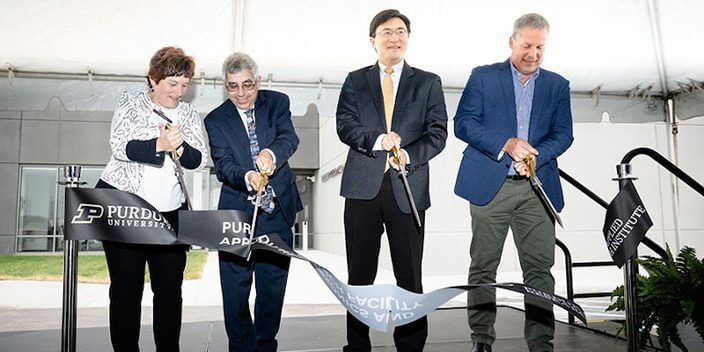Purdue Applied Research Institute opens $41M Hypersonics and Applied Research Facility on campus

WEST LAFAYETTE, Ind. – The Purdue Applied Research Institute (PARI), the applied research arm of Purdue University, on Tuesday (June 6) officially opened a new facility dedicated to enhancing Purdue’s world-leading capabilities in hypersonics evaluation and testing.
Leaders from Purdue, federal government and industry joined PARI leadership and staff in celebrating the opening of the Hypersonics and Applied Research Facility (HARF), a $41 million, 65,000-square-foot building that is home to two cutting-edge wind tunnels – the only Mach 8 quiet wind tunnel in the world and a hypersonic pulse (HYPULSE) reflected shock/expansion tunnel.
It is also home to the Hypersonics Advanced Manufacturing Technology Center, (HAMTC), a single location for industry partners to work on materials and manufacturing innovations and provide access to testing capabilities.
“The Hypersonic Applied Research Facility is an investment in test and evaluation and research capabilities that this country desperately needs,” said Mark Lewis, chief executive officer for PARI. “Through facilities such as HARF, we will help solve some of the most challenging and relevant problems in the field of high-speed flight while also building the future workforce.”
The tunnels recreate different scenarios, such as spacecraft re-entry or missile flight through the atmosphere, as well as replicating unique engine conditions for extremely high-speed propulsion. The Mach 8 quiet wind tunnel and the HYPULSE tunnel offer controlled environments to research several facets of high-speed flight. The wind tunnel more closely simulates flight and provides more accurate data than conventional hypersonic wind tunnels.
The HYPULSE tunnel uses a shock wave of high-temperature air to recreate specific hypersonic flight conditions. It allows flight simulations at speeds ranging from Mach 5 to as high as Mach 40. Purdue will be only the second U.S. university to offer HYPULSE test capabilities.
At HAMTC, located in HARF, researchers can collaborate with industry partners to develop materials and manufacturing innovations. HAMTC is the only vertically integrated prototyping center in the nation that enables the design, manufacturing, joining and testing of hypersonic components and subsystems in one location, speeding time from concept to full-fledged product.
“Flying is part of our Boilermaker DNA, whether three feet above our heads with an autonomous drone or all the way to the moon, and in near space, too,” Purdue President Mung Chiang said at opening events Tuesday. “This is a particularly transformational moment with the opening of HARF; and we are reaffirming here today our unwavering commitment to hypersonic research, testing and talent development for the United States.”
Hypersonic vehicles can travel more than five times the speed of sound and fly in the upper reaches of the atmosphere, significantly challenging an adversary’s ability to detect, track, target and engage. Hypersonic systems are a top Department of Defense priority to help protect U.S. citizens and to ensure battlefield dominance as competitors continue to advance similar programs.
The building is located in Discovery Park District at Purdue, the university’s ever-growing mixed-use innovation hub adjacent to campus, which also includes the Maurice J. Zucrow Laboratories, and is the current or future home to co-located companies such as Rolls-Royce, Saab, Schweitzer Engineering Laboratories and Stratolaunch, which recently established its Advanced Program Office at Convergence Center.
“What’s important in a (peer competitor) race is going fast, and that’s not just flying high, far and fast, like we at Stratolaunch like to do. It is developing those systems quickly, and that only happens when you have a synergistic combination of design tools, ground test facilities, conceptual design capability and then flight test validation,” said Joshua Stults, senior director for advanced programs at Stratolaunch. “Here at Purdue, we’re able to find that synergy, build on the strong basis of ground test facilities that are being invested in here in Indiana, and then go build and fly the aircraft.”
HARF will also be a training ground for students interested in careers in hypersonic research, adding capacity and expanding opportunities for students to get hands-on experiential learning opportunities. Already, more than 100 undergraduate and graduate students work with expert researchers to design, test and evaluate equipment in real-world conditions.
“Students will be involved with research at HARF in almost every step of the way,” Lewis said. “Universities aren’t just places that present new knowledge, they’re places that create new knowledge, and students are essential to that. One of the things you see here at Purdue is that students at all levels – PhD, graduate and undergraduate students are involved in research directly and will be involved directly in the activities at HARF.”
About the Purdue Applied Research Institute
The Purdue Applied Research Institute (PARI) is a nonprofit entity that extends the reach and impact of Purdue University’s deep research strengths and top-ranked academic programs in engineering, agriculture, science and technology. PARI works to improve national security, global development, infrastructure solutions and to accelerate critical technologies. Through applied research and program personnel, state-of-the-art facilities and infrastructure, PARI significantly enhances Purdue’s ability to translate discoveries into innovative solutions and services for mission-oriented government, industry, NGO and foundation partners. pari.purdue.edu